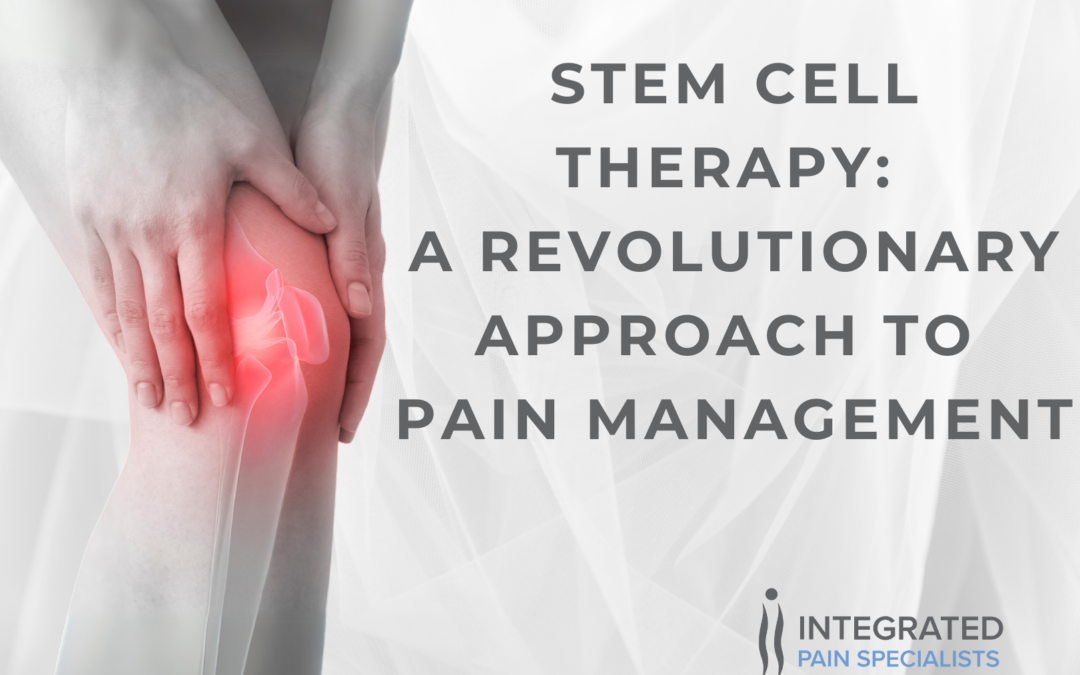Stem cell therapy is an advanced, regenerative treatment designed to heal and repair damaged tissues. At Integrated Pain Specialists, this innovative approach treats conditions like osteoarthritis, joint pain, spinal injuries, and more. Stem cells can regenerate into various cell types, promoting tissue repair and reducing inflammation.
In this article, we will explore the science behind stem cell therapy, its applications, the conditions it treats, and why it is emerging as a powerful option for pain relief.
What Is Stem Cell Therapy?
Stem cell therapy harnesses the natural regenerative power of stem cells to repair damaged tissues and promote healing. Stem cells are undifferentiated cells capable of developing into specialized cells, such as muscle, bone, cartilage, or nerve cells. In stem cell therapy, these cells are harvested, processed, and injected into the affected area to stimulate tissue regeneration.
There are two primary types of stem cells used in this therapy:
- Autologous Stem Cells: These are harvested from the patient’s own body, typically from fat tissue or bone marrow.
- Allogeneic Stem Cells: These come from a donor and are processed to ensure safety before being used in treatments.
How Does Stem Cell Therapy Work?
Stem cell therapy targets damaged tissues, encouraging the body’s natural healing process. Here’s how the treatment typically works:
- Stem Cell Harvesting: Depending on the type of stem cell therapy, cells are extracted either from the patient’s body (autologous) or from a donor (allogeneic). In autologous procedures, fat or bone marrow is often the source of stem cells.
- Processing: Once harvested, the stem cells are processed to concentrate their regenerative properties. In some cases, these cells are multiplied in a lab to increase their effectiveness.
- Injection: The processed stem cells are injected into the affected area, such as a damaged joint, tendon, or spine. These cells then initiate tissue repair and regeneration, reducing inflammation and promoting long-term healing.
Benefits of Stem Cells
Stem cell therapy offers a host of benefits that make it a preferred option for patients dealing with chronic pain and injury:
- Minimally Invasive: Unlike surgeries, stem cell therapy is minimally invasive, requiring only small injections.
- Natural Healing: Stem cells work with your body’s natural healing mechanisms to repair damaged tissues rather than simply masking pain.
- Reduced Recovery Time: Because it’s non-surgical, patients experience shorter recovery periods, with many returning to normal activities within days or weeks.
- Long-Term Pain Relief: The regenerative properties of stem cells can provide lasting relief by healing the underlying cause of pain.
Conditions Treated by Stem Cell Therapy
Stem cell therapy is used to treat various painful conditions, especially those related to joint, spine, and soft tissue damage. Here are some of the common conditions it can address:
1. Osteoarthritis
Osteoarthritis is a degenerative joint disease that causes the breakdown of cartilage. Stem cell therapy can regenerate cartilage, reducing pain and improving joint function. It is particularly effective in treating osteoarthritis in the knees, hips, and shoulders.
2. Spinal Injuries
Stem cells are used to treat spinal injuries and chronic back pain. By promoting the regeneration of damaged discs, ligaments, and nerves, stem cell therapy offers a non-surgical option for spine health.
3. Joint Injuries
Whether it’s from trauma or wear and tear, joint injuries can cause chronic pain and restricted movement. Stem cell therapy can accelerate healing and reduce pain in joints such as the knees, elbows, and ankles.
4. Tendon and Ligament Injuries
Tendon and ligament injuries, such as rotator cuff tears or ACL injuries, benefit from stem cell therapy. The regenerative cells help repair torn tissues, leading to faster recovery without the need for surgery.
5. Chronic Pain
For patients with chronic pain who have not found relief from traditional treatments, stem cell therapy can offer an alternative by addressing the root cause of pain, particularly in cases of arthritis, back pain, and soft tissue injuries.
The Science Behind Stem Cells
Stem cells work by reducing inflammation, promoting tissue regeneration, and aiding in the repair of damaged cells. When stem cells are injected into an area of damage, they release growth factors that:
- Encourage new tissue growth
- Reduce inflammation
- Modulate the immune system
- Replace damaged cells with healthy, functional cells
Stem cells also have the potential to repair tissues that cannot heal on their own. For example, cartilage in joints cannot regenerate, but stem cell therapy can help stimulate cartilage repair, offering relief for patients with degenerative joint diseases.
What to Expect During the Stem Cell Procedure
Stem cell therapy is a straightforward procedure performed in an outpatient setting. Here’s what patients can typically expect:
- Consultation: The process begins when a physician assesses the patient’s condition and determines whether they are a good candidate for stem cell therapy.
- Harvesting: If autologous stem cells are being used, the cells are harvested from the patient’s body, usually from fat tissue or bone marrow. The harvesting procedure is minimally invasive and performed under local anesthesia.
- Processing: The harvested stem cells are processed in a specialized lab to concentrate them for maximum effectiveness.
- Injection: Once the stem cells are prepared, they are injected into the affected area under ultrasound or fluoroscopy guidance to ensure accuracy.
- Recovery: Patients are monitored for a short period and can typically return home the same day. Recovery time varies but is usually minimal, with patients resuming normal activities within days to weeks.
Risks and Side Effects of Stem Cells
Stem cell therapy is generally considered safe, especially when using autologous cells from the patient’s own body. However, as with any medical procedure, there are some risks and potential side effects, including:
- Infection at the injection site
- Mild pain or swelling
- Allergic reactions (in rare cases)
These risks are minimal, and most patients tolerate the procedure well with few complications.
Stem Cell Therapy vs. Surgery
For patients facing the prospect of surgery, stem cell therapy offers a less invasive alternative. While surgery may be necessary in severe cases, stem cell therapy can often provide relief without the risks and lengthy recovery associated with surgical procedures.
Here’s how stem cell therapy compares to surgery:
- Minimally Invasive: Stem cell therapy involves injections rather than incisions, reducing recovery time and minimizing risks.
- Faster Recovery: While surgery can take weeks or months to recover from, stem cell therapy typically allows patients to return to daily activities much sooner.
- Lower Risk: Surgery carries risks of complications, infections, and anesthesia-related issues, while stem cell therapy has fewer and less severe risks.
- No Hospitalization: Stem cell therapy is performed in an outpatient setting, meaning no hospital stay is required.
Conclusion
Stem cell therapy is an exciting, cutting-edge treatment for chronic pain and tissue damage. Whether you’re dealing with osteoarthritis, a spinal injury, or a joint problem, stem cell therapy offers a minimally invasive, regenerative option that can help alleviate pain and promote healing.
At Integrated Pain Specialists, we provide personalized stem cell treatments to help patients regain mobility, reduce pain, and enhance their quality of life. If you’re interested in exploring stem cell therapy, consult with our team to determine if it’s the right option for you.

